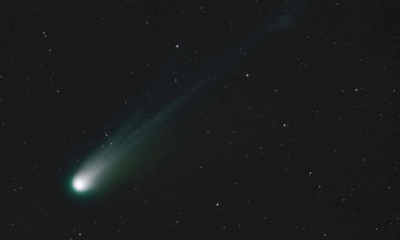Science
Largest Martian Meteorite on Earth Heads to Auction for £3 Million

A remarkable piece of extraterrestrial history is set to be auctioned in New York this week. The largest Martian meteorite ever discovered on Earth, weighing an impressive 25 kilograms, will be sold at a natural history-themed auction hosted by Sotheby’s on July 14, 2025. This extraordinary rock, known as NWA 16788, is expected to fetch between £1.5 million and £3 million (approximately $2 million to $4 million).
As of now, the current bid stands at £1.2 million (around $1.6 million), reflecting the rarity of this celestial specimen. Measuring 15 by 11 by 6 inches (or 38 by 28 by 15 cm), NWA 16788 is nearly 70 percent larger than any other known Martian meteorite on Earth. According to Sotheby’s, this meteorite accounts for approximately seven percent of all Martian material currently on our planet.
A Rare Journey from Mars to Earth
Martian meteorites are formed when massive asteroid impacts blast debris into space, allowing fragments to traverse the vast distance of 140 million miles to reach Earth. These meteorites are exceedingly rare; only about 400 Martian meteorites have been officially confirmed on Earth, compared to around 77,000 meteorites from other sources. The size of NWA 16788 has led astronomers to conclude that only 19 craters on Mars are large enough to have ejected it from the planet’s surface.
Cassandra Hatton, Vice Chairman for Science and Natural History at Sotheby’s, described this meteorite as “the largest piece of Mars we have ever found by a long shot.” She noted that it is more than double the size of the previous record holder. Found in Niger by a meteorite hunter in 2023, the rock exhibits a glassy-smooth surface, indicative of the intense heat it endured while entering Earth’s atmosphere.
Scientific Significance and Composition
The analysis of NWA 16788 revealed that it had not been on Earth’s surface for long, supporting the idea that it is a relatively recent arrival. Laboratory tests confirmed its Martian origin, comparing its chemical composition to data collected by the NASA Viking Lander in 1976. Significant portions of the meteorite consist of a type of glass known as maskelynite, formed under conditions of extreme heat and pressure during its journey through space. The remainder of the rock is primarily composed of a material known as olivine-microgabbroic shergottite, formed from the slow cooling of Martian magma. This specific composition is found in only 5.4 percent of Martian meteorites, adding to its rarity.
Previously, NWA 16788 was on display at the Italian Space Agency in Rome, though Sotheby’s has not disclosed the identity of its current owner. The auction will also feature other notable items, including a 2.5-kilogram sphere of moon rock and fragments from a meteor that exploded over Siberia in 1947.
Alongside these space-related items, the auction will showcase the mounted skeleton of a juvenile Ceratosaurus, a dinosaur from the late Jurassic period. Experts estimate that this fossil will sell for between $3 million and $4.5 million (approximately £4 million to £6 million).
The auction underscores the fascination with celestial objects and the ongoing appeal of the universe’s mysteries. As collectors and enthusiasts prepare for this unique opportunity, the sale of NWA 16788 highlights the intersection of science, history, and the potential for ownership of a tangible piece of another world.

-

 Entertainment3 months ago
Entertainment3 months agoAnn Ming Reflects on ITV’s ‘I Fought the Law’ Drama
-

 Entertainment4 months ago
Entertainment4 months agoKate Garraway Sells £2 Million Home Amid Financial Struggles
-

 Health3 months ago
Health3 months agoKatie Price Faces New Health Concerns After Cancer Symptoms Resurface
-

 Entertainment3 months ago
Entertainment3 months agoCoronation Street’s Carl Webster Faces Trouble with New Affairs
-

 Entertainment2 months ago
Entertainment2 months agoWhere is Tinder Swindler Simon Leviev? Latest Updates Revealed
-

 Entertainment4 months ago
Entertainment4 months agoMarkiplier Addresses AI Controversy During Livestream Response
-

 Science1 month ago
Science1 month agoBrian Cox Addresses Claims of Alien Probe in 3I/ATLAS Discovery
-

 Entertainment4 months ago
Entertainment4 months agoKim Cattrall Posts Cryptic Message After HBO’s Sequel Cancellation
-

 Entertainment2 months ago
Entertainment2 months agoOlivia Attwood Opens Up About Fallout with Former Best Friend
-

 Entertainment3 months ago
Entertainment3 months agoMasterChef Faces Turmoil as Tom Kerridge Withdraws from Hosting Role
-

 Entertainment4 months ago
Entertainment4 months agoSpeculation Surrounds Home and Away as Cast Departures Mount
-

 World2 months ago
World2 months agoCole Palmer’s Mysterious Message to Kobbie Mainoo Sparks Speculation



















